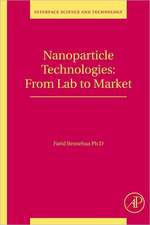Chemometrics in Food Chemistry: Data Handling in Science and Technology, cartea 28
Federico Marinien Limba Engleză Hardback – 21 iun 2013
For food science in general and food analysis and control in particular, there are several problems for which chemometrics are of utmost importance. Traceability, i.e. the possibility of verifying the animal/botanical, geographical and/or productive origin of a foodstuff, is, for instance, one area where the use of chemometric techniques is not only recommended but essential: indeed, at present no specific chemical and/or physico-chemical markers have been identified that can be univocally linked to the origin of a foodstuff and the only way of obtaining reliable traceability is by means of multivariate classification applied to experimental fingerprinting results.
Another area where chemometrics is of particular importance is in building the bridge between consumer preferences, sensory attributes and molecular profiling of food: by identifying latent structures among the data tables, bilinear modeling techniques (such as PCA, MCR, PLS and its various evolutions) can provide an interpretable and reliable connection among these domains. Other problems include process control and monitoring, the possibility of using RGB or hyperspectral imaging techniques to nondestructively check food quality, calibration of multidimensional or hyphenated instruments etc.
Din seria Data Handling in Science and Technology
- 23%
 Preț: 1053.94 lei
Preț: 1053.94 lei - 27%
 Preț: 1765.52 lei
Preț: 1765.52 lei - 27%
 Preț: 1757.66 lei
Preț: 1757.66 lei - 27%
 Preț: 1371.81 lei
Preț: 1371.81 lei - 27%
 Preț: 1762.70 lei
Preț: 1762.70 lei - 27%
 Preț: 1277.61 lei
Preț: 1277.61 lei - 27%
 Preț: 1501.83 lei
Preț: 1501.83 lei - 20%
 Preț: 1648.82 lei
Preț: 1648.82 lei - 27%
 Preț: 1028.03 lei
Preț: 1028.03 lei - 24%
 Preț: 923.37 lei
Preț: 923.37 lei - 20%
 Preț: 759.90 lei
Preț: 759.90 lei - 37%
 Preț: 761.10 lei
Preț: 761.10 lei - 29%
 Preț: 1013.94 lei
Preț: 1013.94 lei - 28%
 Preț: 1023.88 lei
Preț: 1023.88 lei -

Preț: 808.91 lei
Preț vechi: 1129.80 lei
-28% Nou
Puncte Express: 1213
Preț estimativ în valută:
154.78€ • 161.61$ • 128.10£
154.78€ • 161.61$ • 128.10£
Carte tipărită la comandă
Livrare economică 28 martie-11 aprilie
Preluare comenzi: 021 569.72.76
Specificații
ISBN-13: 9780444595287
ISBN-10: 0444595287
Pagini: 512
Dimensiuni: 152 x 229 x 35 mm
Greutate: 0.85 kg
Editura: ELSEVIER SCIENCE
Seria Data Handling in Science and Technology
ISBN-10: 0444595287
Pagini: 512
Dimensiuni: 152 x 229 x 35 mm
Greutate: 0.85 kg
Editura: ELSEVIER SCIENCE
Seria Data Handling in Science and Technology
Public țintă
Food scientists, analytical chemists and chemometriciansCuprins
1. Introduction, Federico Marini
Theory
2. Experimental Design, Riccardo Leardi
3. Exploratory Data Analysis, Mario Li Vigni, Caterina Durante, and Marina Cocchi
4. Regression, Frank Westad, Marta Bevilacqua, and Federico Marini
5. Classification and Class-Modelling, M. Bevilacqua, R. Bucci, A.D. Magrì, A.L. Magrì, R. Nescatelli, and F. Marini
6. Multivariate Curve Resolution Methods for Food Chemistry, Anna de Juan and Sílvia Mas
7. Multi Way Methods, José Manuel Amigo and Federico Marini
8. Robust Methods in Analysis of Multivariate Food Chemistry Data, Stanimirova, M. Daszykowski, and B. Walczak
Applications
9. Hyperspectral Imaging and Chemometrics: A Perfect Combination for the Analysis of Food Structure, Composition and Quality, José Manuel Amigo, Idoia Martí, and Aoife Gowen
10. The Impact of Chemometrics on Food Traceability, Lucia Bertacchini, Marina Cocchi, Mario Li Vigni, Andrea Marchetti, Elisa Salvatore, Simona Sighinolfi, Michele Silvestri, and Caterina Durante
11. NMR-Based Metabolomics in Food Quality Control, A. Tomassini, G. Capuani, M. Delfini, and A. Miccheli
12. Interval Based Chemometric Methods in NMR-Foodomics, Francesco Savorani, Morten Arendt Rasmussen, Åsmund Rinnan, and Søren Balling Engelsen
Theory
2. Experimental Design, Riccardo Leardi
3. Exploratory Data Analysis, Mario Li Vigni, Caterina Durante, and Marina Cocchi
4. Regression, Frank Westad, Marta Bevilacqua, and Federico Marini
5. Classification and Class-Modelling, M. Bevilacqua, R. Bucci, A.D. Magrì, A.L. Magrì, R. Nescatelli, and F. Marini
6. Multivariate Curve Resolution Methods for Food Chemistry, Anna de Juan and Sílvia Mas
7. Multi Way Methods, José Manuel Amigo and Federico Marini
8. Robust Methods in Analysis of Multivariate Food Chemistry Data, Stanimirova, M. Daszykowski, and B. Walczak
Applications
9. Hyperspectral Imaging and Chemometrics: A Perfect Combination for the Analysis of Food Structure, Composition and Quality, José Manuel Amigo, Idoia Martí, and Aoife Gowen
10. The Impact of Chemometrics on Food Traceability, Lucia Bertacchini, Marina Cocchi, Mario Li Vigni, Andrea Marchetti, Elisa Salvatore, Simona Sighinolfi, Michele Silvestri, and Caterina Durante
11. NMR-Based Metabolomics in Food Quality Control, A. Tomassini, G. Capuani, M. Delfini, and A. Miccheli
12. Interval Based Chemometric Methods in NMR-Foodomics, Francesco Savorani, Morten Arendt Rasmussen, Åsmund Rinnan, and Søren Balling Engelsen
Recenzii
"As this book is aimed not only at professional chemometricians, all the topics (especially those in the theoretical part) are covered extensively starting from beginner level up to an intermediate or advanced one. The descriptions of the methods used are accompanied by examples taken from Food Science to illustrate how the different techniques can be fruitfully applied to solve real-world food-related issues." --FST Magazine, February 2014














